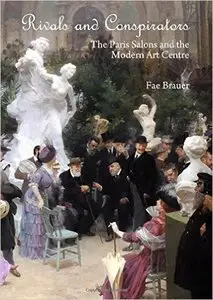Fae Brauer, "Rivals and Conspirators: the Paris Salons and the Modern Art Centre"
English | ISBN: 1443853763 | 2013 | 457 pages | PDF | 32 MB
English | ISBN: 1443853763 | 2013 | 457 pages | PDF | 32 MB
Once the State-run Salon in Paris closed, an array of independent Salons mushroomed starting with the French Artists Salon and Women's Salon in 1881 followed by the Independent Artists' Salon, National Salon of Fine Arts and Autumn Salon. Offering an unparalleled choice of art identities and alliances, together with undreamed-of opportunities for sales, commissions, prizes and art criticism, these great Salons guaranteed the centripetal and centrifugal power of Paris as the "modern art centre". Lured by the prospect of being exhibited annually in Salons the size of Biennales today, a huge number and national diversity of artists, from the Australian Rupert Bunny to the Spaniards Pablo Picasso and Juan Gris, flocked to Paris. Yet by no means were these Salons equal in power, nor did they work consensually to forge this "modern art centre". Formed on the basis of their different cultural politics, constantly they rivalled one another for State acquisitions and commissions, exhibition places and spaces, awards, and every other means of enhancing their legitimacy. By no means were the avant-garde salons those that most succeeded. Instead, as this culturo-political history demonstrates, the French Artists' and National Fine Art Salons were the most successful, with the genderist French Artists' Salon being the most powerful and "official". Despite the renown today of Neo-Impressionism, Art Nouveau, Fauvism, Cubism and Orphism, the most powerful artists in this "modern art centre" were not Sonia Delaunay, Emile Galle, Paul Signac, Henri Matisse or even Picasso but such Academicians as Leon Bonnat, William Bouguereau, Fernand Cormon, Edouard Detaille, Gabriel Ferrier, Jean-Paul Laurens, Luc-Oliver Merson and Aime Morot, who exhibited at the "official" Salon supported by the machinery of the State. In its exposure of the rivalry, conflict and struggle between the Salons and their artists, this is an unprecedented history of dissension. It also exposes how, just below the welcoming internationalist veneer of this "modern art centre", intense persecutionist paranoia lay festering. Whenever France's "civilizing mission" seemed culturally, commercially or colonially threatened, it erupted in waves of nationalist xenophobia turning artistic rivalry into bitter enmity. In exposing how rivals became transmuted into conspirators, ultimately this book reveals a paradox resonant in histories that celebrate the international triumph of French modern art: that this magnetic "centre", which began by welcoming international modernists, ended by attacking them for undermining its cultural supremacy, contaminating its "civilizing mission" and politically persecuting the very modernist culture for which it has received historical renown.



